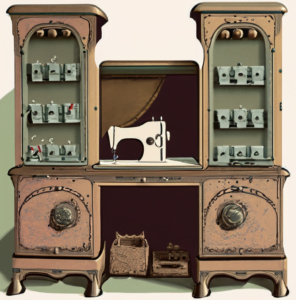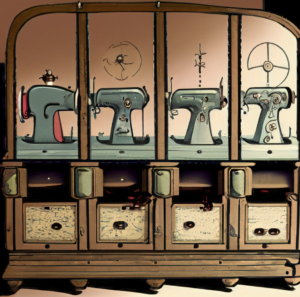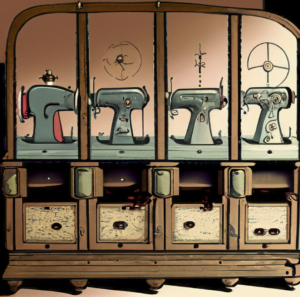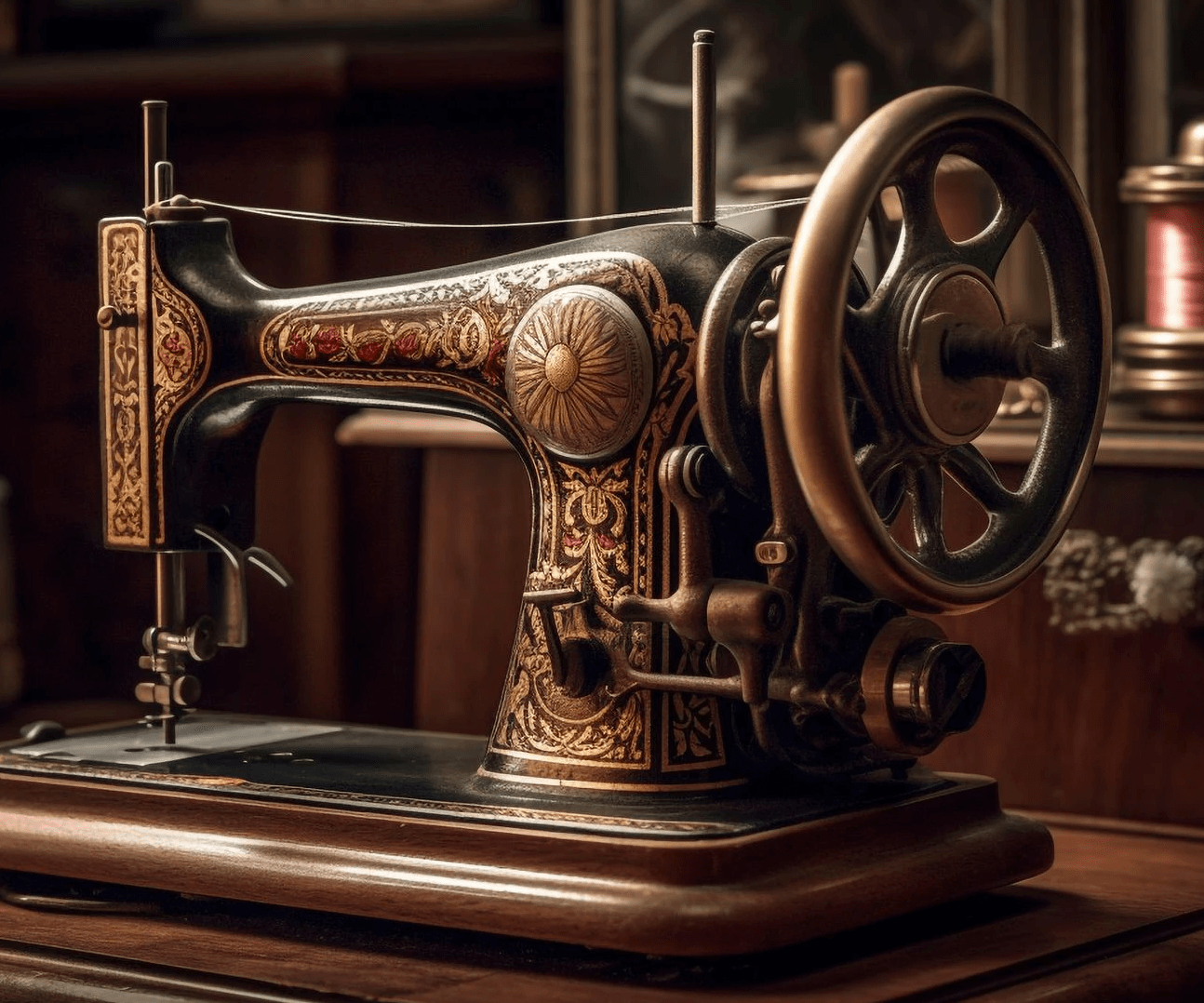
Introduction
Welcome to our comprehensive guide on vintage sewing machine cabinets! In this article, we will explore the fascinating world of these timeless treasures. Vintage sewing machine cabinets not only serve as functional storage solutions but also hold immense historical and sentimental value. Whether you are a passionate collector, a sewing enthusiast, or simply curious about the history of sewing machines, this article will provide you with a wealth of information.
Table of Contents
- Understanding Vintage Sewing Machine Cabinets
- What is a vintage sewing machine cabinet?
- The evolution of sewing machine cabinets over time
- Exploring the Features and Design
- Classic styles and materials used
- Innovative storage compartments
- The Significance of Vintage Sewing Machine Cabinets
- Historical value and cultural impact
- Collectible items and their market demand
- Restoring and Maintaining Vintage Sewing Machine Cabinets
- Cleaning and preserving the cabinet’s finish
- Repairing common issues and damages
- Showcasing Vintage Sewing Machine Cabinets
- Display options for maximum visual appeal
- Incorporating cabinets into home decor
- Frequently Asked Questions (FAQs)
- 6.1. How do I determine the age of a vintage sewing machine cabinet?
- 6.2. Can I repurpose a vintage sewing machine cabinet for other uses?
- 6.3. What are some popular brands of vintage sewing machine cabinets?
- 6.4. Where can I find authentic vintage sewing machine cabinets for purchase?
- 6.5. Are vintage sewing machine cabinets a good investment?
- 6.6. How can I ensure the authenticity of a vintage sewing machine cabinet?
- Conclusion
1. Understanding Vintage Sewing Machine Cabinets

These are exquisite pieces of furniture that were specifically designed to house and conceal sewing machines. These cabinets were crafted with precision and attention to detail, embodying the craftsmanship of a bygone era. They served as more than mere storage units, providing a dedicated space for sewing enthusiasts to work on their projects.
1.1. What is a vintage sewing machine cabinet?
These are specialised piece of furniture that encloses a sewing machine and provides storage compartments for sewing supplies. These cabinets were primarily manufactured during the 19th and 20th centuries when sewing machines gained popularity among households. They were meticulously designed to house specific sewing machine models and accommodate various sewing accessories.
1.2. The evolution of sewing machine cabinets over time
The design of sewing machine cabinets has evolved significantly over the years. In the early days, cabinets were typically made of wood and featured ornate carvings and decorative accents. As technology progressed, cabinets became more streamlined and functional. Modern sewing machine cabinets often incorporate additional features like adjustable work surfaces, built-in lighting, and ergonomic storage solutions.
2. Exploring the Features and Design

These boast a range of unique features and captivating designs that make them stand out as timeless pieces of furniture.
2.1. Classic styles and materials used
These are crafted in various styles to suit the prevailing aesthetic preferences of different eras. Some popular styles include Victorian, Art Deco, and Mid-century Modern. These cabinets were predominantly made from high-quality woods such as oak, mahogany, and walnut, which were known for their durability and rich, warm tones.
2.2. Innovative storage compartments
One of the defining characteristics of vintage sewing machine cabinets is their ingenious storage compartments. These cabinets often feature drawers, cubbies, and hidden compartments specifically designed to accommodate sewing supplies such as thread spools, needles, thimbles, and fabric shears. The thoughtful organisation of these compartments allowed sewers to keep their tools within easy reach, enhancing efficiency and productivity.
3. The Significance of Vintage Sewing Machine Cabinets

These hold immense historical and cultural significance, reflecting the evolution of sewing technology and the role of women in society.
3.1. Historical value and cultural impact
These provide a glimpse into the past, showcasing the ingenuity of earlier generations. They serve as a testament to the advancements in sewing technology and the craftsmanship of artisans who created these beautiful pieces. Moreover, sewing machines and their accompanying cabinets played a vital role in empowering women by enabling them to engage in sewing as a means of self-expression and income generation.
3.2. Collectible items and their market demand
These are become highly sought after by collectors and sewing enthusiasts alike. The scarcity of well-preserved cabinets, combined with their historical significance, has contributed to their increasing market demand. Collectors often seek out specific brands, models, or unique design features, making vintage sewing machine cabinets valuable additions to any collection.
4. Restoring and Maintaining Vintage Sewing Machine Cabinets
Preserving the original beauty of vintage sewing machine cabinets requires proper restoration techniques and regular maintenance.
4.1. Cleaning and preserving the cabinet’s finish
When cleaning a vintage sewing machine cabinet, it is crucial to use gentle cleaning agents and non-abrasive methods. Regular dusting and waxing help maintain the cabinet’s finish and protect it from environmental factors. Restoring the cabinet’s original luster may involve refinishing or repairing any surface damages under the guidance of a professional.
4.2. Repairing common issues and damages
Over time, these may experience issues such as loose hinges, cracked wood, or damaged veneer. Repairing these issues often requires specialised woodworking skills and an understanding of antique furniture restoration techniques. Seeking the assistance of an experienced restorer can ensure that the repairs are done correctly, preserving the cabinet’s authenticity and value.
5. Showcasing Vintage Sewing Machine Cabinets
Displaying vintage sewing machine cabinets can transform them into captivating focal points within your home decor.
5.1. Display options for maximum visual appeal
Choose a prominent location in your home to showcase your vintage sewing machine cabinet. Consider positioning it in a well-lit area, such as near a window or under a stylish pendant light, to highlight its intricate details. Additionally, incorporating complementary decorative items, such as vintage sewing accessories or fabric swatches, can enhance the overall aesthetic appeal of the display.
5.2. Incorporating cabinets into home decor
These can be repurposed to serve as unique and functional elements in your home decor. For example, you can transform a sewing machine cabinet into a stylish side table by removing the sewing machine and utilising the cabinet’s surface. Adding a decorative table lamp or a potted plant can further accentuate its newfound purpose.
6. Frequently Asked Questions (FAQs)
6.1. How do I determine the age of a vintage sewing machine cabinet?
To determine the age of a vintage sewing machine cabinet, you can examine its design elements, construction techniques, and any manufacturer’s labels or markings. Consulting reference books, online resources, or seeking the advice of experienced collectors can also provide valuable insights into dating your cabinet.
6.2. Can I repurpose a vintage sewing machine cabinet for other uses?
Yes, These can be repurposed in various creative ways. With a little imagination, you can transform them into unique pieces of furniture that suit your specific needs. Some popular repurposing ideas include converting them into bathroom vanities, kitchen islands, or storage cabinets for crafts and art supplies. The sturdy construction of vintage sewing machine cabinets makes them ideal for repurposing projects.
6.3. What are some popular brands of vintage sewing machine cabinets?
Several renowned brands manufactured vintage sewing machine cabinets, each with its own distinctive style and craftsmanship. Some popular brands include Singer, White, Pfaff, and Bernina. These brands are known for producing high-quality sewing machines and cabinets that have stood the test of time.
6.4. Where can I find authentic vintage sewing machine cabinets for purchase?
These can be found through various sources. Antique stores, flea markets, and estate sales are great places to start your search. Online platforms such as eBay and Etsy also offer a wide selection of vintage sewing machine cabinets. When purchasing online, ensure that the seller provides detailed information, clear photographs, and guarantees the authenticity of the cabinet.
6.5. Are vintage sewing machine cabinets a good investment?
It can be a worthwhile investment for collectors and enthusiasts. The market demand for well-preserved cabinets continues to rise, making them a potentially valuable asset. However, it is important to research the market, seek expert advice, and carefully evaluate the condition and authenticity of the cabinet before making a purchase.
6.6. How can I ensure the authenticity of a vintage sewing machine cabinet?
Ensuring the authenticity of a vintage sewing machine cabinet requires thorough examination and research. Look for manufacturer’s labels, stamps, or serial numbers that can help identify the brand and age of the cabinet. Consult reference books, online forums, and reputable experts to validate the information and gain a better understanding of the cabinet’s history.
7. Conclusion
These encapsulate the beauty, craftsmanship, and historical significance of a bygone era. As functional storage solutions and collector’s items, these cabinets have a timeless appeal that continues to captivate sewing enthusiasts and antique lovers. By understanding their features, preserving their condition, and incorporating them into home decor, you can celebrate the legacy of vintage sewing machine cabinets and cherish them as cherished pieces of history.

